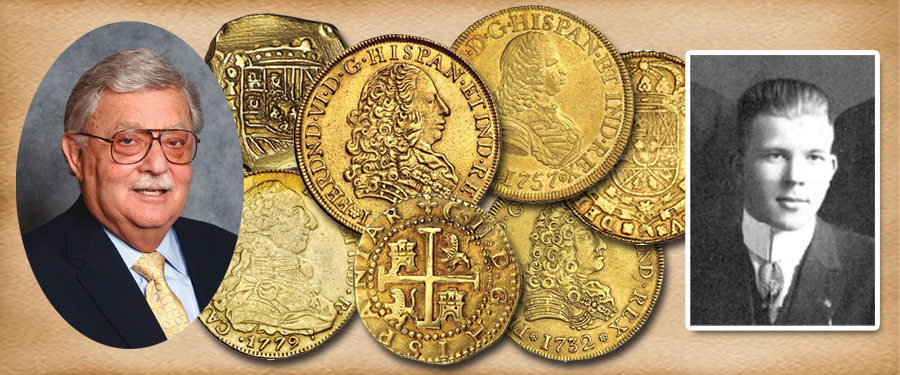
In the last few months of 1953 and into the first
half of 1954 there was much excitement and planning in the numismatic hobby.
This was because the collection of King Farouk of Egypt was being cataloged to
be sold in Cairo in the spring of 1954. At Stack’s we were very
busy preparing the Anderson-Dupont and Davis Graves catalogs for our pending auctions.
All this
kept the numismatic press busy, and public interest in the sales in Cairo, and our
in New
York was very high as a result of much new material on the market.
In early spring 1954, Josiah K Lilly made one of
his semi-annual stops in New York and as was customary, he stopped
in to visit at Stack’s. He inquired what was happening with the coins in
Cairo, and what new things had we uncovered to add to his collection. He
was happy to examine the Schermerhorn Collection of Double Eagles, ($20 gold). He
liked the overall quality and noticed that a few were still missing. We informed him that
we were seeking the others, which were primarily in the Saint-Gaudens
series. We discussed how the banks in Europe had many U.S. $20 gold still
buried in
their vaults, and spoke of our concern that many previous rare dates might be
part of
these hoards. We advised Mr. Lilly, as we did other collectors, that
they should
not jump to buy these “rarer dates,” as it was possible that a
quantity could suddenly appear on the market. Mr. Lilly agreed. We billed him for the
Schermerhorn Collection, and he said he would be patient.
Next we reviewed the foreign gold coins we had
assembled. But we weren’t done! Mr. Lilly asked, “Since I am now adding the
U.S. double eagles to my gold coin collection,
what about the other denominations?” We spent an hour explaining the
other
denominations and he expressed interest in expanding his United States gold
collection.
“I would prefer if you could find some of the
other U.S. coin series, as partial sets or
even complete denominations, as you did years ago with Louis Eliasberg, King
Farouk, and others we talked about. I could get a good head start, as I know
that there are some sets of these in existence. Is it possible?” Mr. Lilly
asked.
Earlier we had spoken about our good fortune in
getting for outright purchase, the coins in the Davis-Graves and Anderson
Dupont collections. We had told Mr. Lilly how those two acquisitions had
precluded our attendance at the Cairo sale.
We then showed him the sets of gold coins from the
Anderson-Dupont collection that we were in the process of cataloging for a fall
auction. From that collection, we had four (4) different complete sets of lower
denomination U.S. gold coins. Each set was housed in beautiful leather boxes, lined with deep purple velvet, as they
were when we bought the collection. Each coin from each issue and mint were
systematically
stored side by side; just opening the boxes was a dazzling experience. !!!
The cases contained:
• A complete set of gold dollars, 1849 to 1889, all
dates and mints, primarily in brilliant Uncirculated or Proof.
• A complete set of quarter eagles, 1796 to 1929,
all dates and mints primarily in brilliant Uncirculated or Proof.
• A complete set of $3 gold pieces, all dates and
mints (no 1970-S), primarily in brilliant Uncirculated or Proof.
• A complete set of $4 gold Stellas, including the
1879 and 1880 Flowing Hair and Coiled Hair, all four in superb Proof.
Looking at the sets, examining them carefully was
like seeing the “crown jewels of
numismatics.” Mr. Lilly was pleased with what he saw, it would meet
his needs not to have to try to assemble these beautiful, rare and popular series
at one time. Of course he inquired, “How much for the four sets?”
We responded ” $ 50,000.” He looked up at
us with a twinkle in his eye and said, “I will take them.” For those who want to
consider the deal he got, prices were far lower in the 1950s, and many of the coins
he acquired would now be five, six, or seven figure coins on the 2016 coin
market. My, how coins have grown
in value.
After this transaction was completed, Mr. Lilly
asked: “Now that I own the $1, $2.50, $3, $4 and almost a full set of $20,
how do I gather the $5 and $10 gold sets?” We told
him the story of our purchase of the Col. E.H.R. Green Collection from the Chase
Bank in 1943-1944 and the $5 and $10 gold coins it contained. From this vast
hoard we were able to make virtually complete sets of these denominations that
we sold to King Farouk at the time. We also were able to assemble virtually complete
sets of $5 and $10 gold coins for Clifford T. Weihman, (who was
considered “the olive oil king”) and who still had his coins.
Mr. Lilly, with a smile on his face said ”
Well maybe he has some left for me!” We all laughed and told him that we would
investigate. He thanked us for our help in achieving his goals from when
he first walked into our shop to talk about “Pirate Gold.” He also expressed
his gratitude for our assistance and expertise as he expanded his collection
into other series. To get such a compliment from such a dedicated collector warms my heart
to this day.
We arranged for a delivery and set a date in May to
hand carry his coins to him and to visit “Eagle’s Nest” again.





